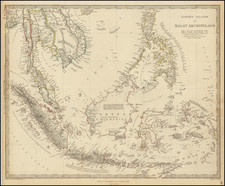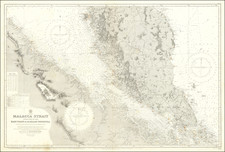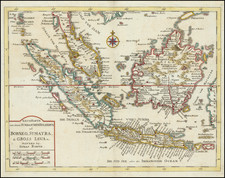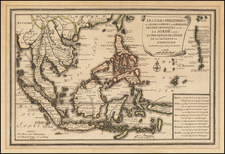Rare view of Penang, from François Balthazar Solvyns' rare work.
The Penang view appeared in the French edition of Solvyns work only.
Rare colored example of Solvyns view.
A native of Antwerp, Balthazar Solvyns set sail for India in 1790, arriving in Calcutta the following year. Having undertaken a commission in 1792 for Alexander Kyd, the Surveyor-General in Calcutta, in which he provided illustrations for a report written for the East India Company on Kyd's expedition to Penang and the Andaman Islands, Solvyns noticed the keen interest shown by the British in Indian costumes and ways of life. This led him to produce his comprehensive work on India, A Collection of Two Hundred and Fifty Coloured Etchings Descriptive of the Manners, Customs, and Dress of the Hindoos (Calcutta, 1799, 4°), encouraged by the orientalist, Sir William Jones. He issued the enlarged and improved French folio edition, Les Hindous, in 48 parts from 1808-1812, with colored plates and an English translation by his English wife, Mary Anne Greenwood Solvyns.
Penang
The modern history of Penang begins in the 1770s, when Francis Light was ordered by the British East India Company to form trade relations in the Malay Peninsula. Light subsequently landed in Kedah, which was by then a Siamese vassal state.
In 1786, the British East India Company ordered Light to obtain the island from Kedah. Light negotiated with the new Sultan of Kedah, Sultan Abdullah Mukarram Shah, regarding the cession of the island to the British East India Company in exchange for British military aid. Light and his entourage sailed on to Penang Island, where they arrived on 17 July 1786. Penang Island was renamed the Prince of Wales Island, while the new settlement of George Town was established in honor of King George III.
In 1800, Lieutenant-Governor Sir George Leith secured a strip of hinterland across the Penang Strait and named it Province Wellesley (now Seberang Perai). Province Wellesley was then gradually expanded up to its present-day boundaries in 1874 In exchange for the acquisition, the annual payment to the Sultan of Kedah was increased to 10,000 Spanish dollars per annum.
Light founded George Town as a free port to entice traders away from nearby Dutch trading posts. Maritime trade at the Port of Penang grew exponentially; the number of incoming vessels rose from 85 in 1786 to 3,569 in 1802.
In 1805, Penang became a separate presidency of British India, sharing similar status with Bombay and Madras. By 1808, a local government for George Town was in place. In 1826, Penang, Singapore and Malacca were incorporated into the Straits Settlements, with George Town as the capital.
Rarity
The view is very rare on the market, this being the first example we have seen.











![[Singapore Strait] A Plan of the Soundings from Pulo Aor to the Southward and outside of the Reef off Point Romania towards the entrance of Sincapour Strait. with the Land adjacent and the relative positions of the Hills, &c. . . . 1818](https://storage.googleapis.com/raremaps/img/small/60508op.jpg)
![Asiatic Archipelago [Early Singapore Inset]](https://storage.googleapis.com/raremaps/img/small/66879.jpg)

